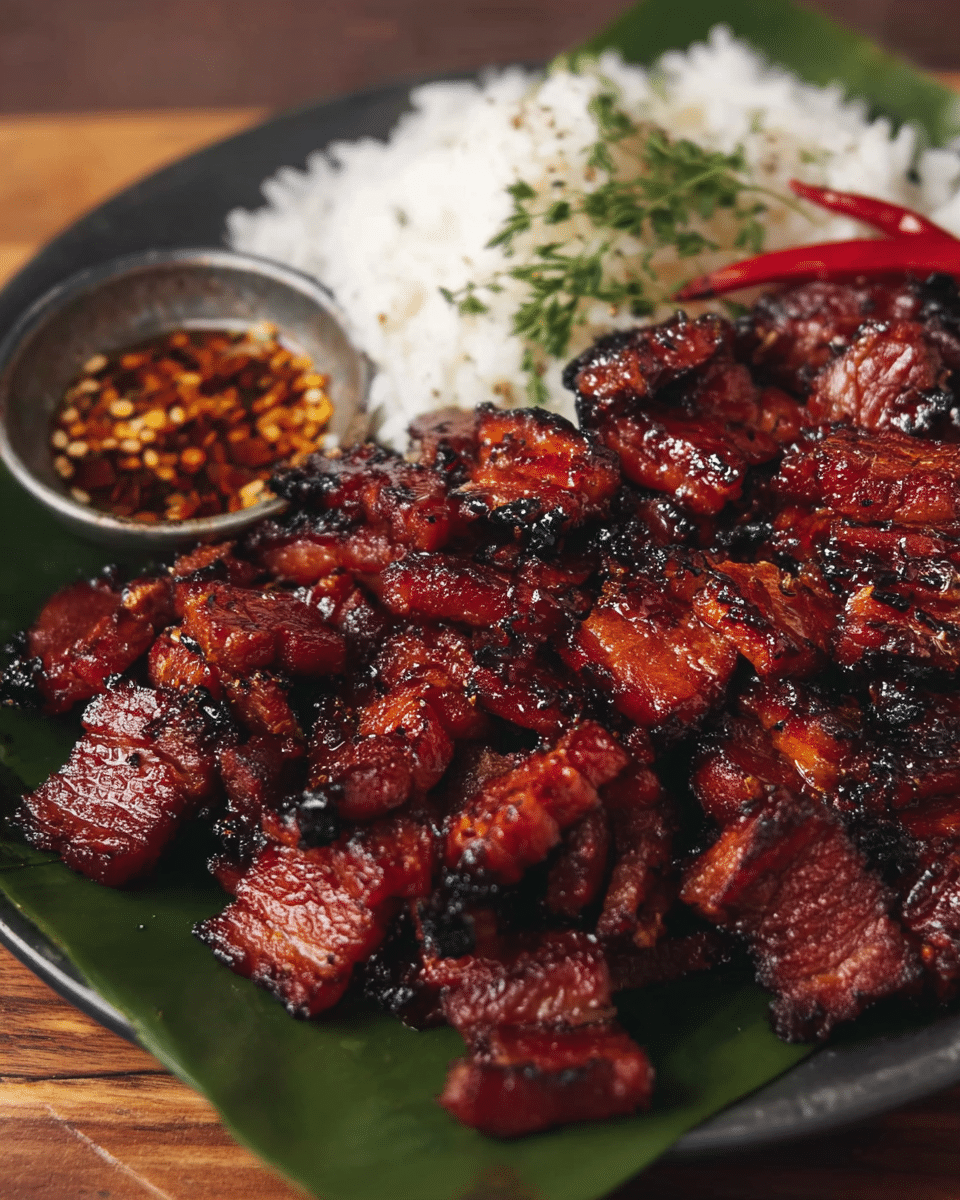Filipino Pork Tocino is a classic breakfast dish that’s both sweet and savory. This dish features marinated pork cooked until tender and caramelized, often served with garlic fried rice (sinangag) and a fried egg. It’s a must-try for anyone who loves flavorful, tender pork with a touch of sweetness. Originating from Pampanga, this recipe brings authentic Filipino flavors right to your kitchen.
Full Recipe:
Ingredients:
-
450g (1 lb) Pork Shoulder, sliced into ¼ inch pieces
-
¼ cup brown sugar
-
¼ cup pineapple juice
-
2 tablespoons soy sauce
-
1 tablespoon vinegar
-
6 cloves garlic, minced
-
1 teaspoon salt
-
¼ teaspoon black pepper
-
6 drops red food coloring (optional)
-
2 tablespoons oil for cooking
Directions:
-
Slice the pork shoulder into ¼ inch pieces.
-
In a bowl, combine the brown sugar, pineapple juice, soy sauce, vinegar, garlic, salt, pepper, and red food coloring. Stir until well mixed.
-
Add the sliced pork to the marinade, ensuring all pieces are coated. Cover and marinate for 24 hours in the fridge.
-
Heat oil in a pan over medium-low heat. Add the marinated pork to the pan.
-
Cook for 10-12 minutes, flipping the pork every minute to prevent burning, until it’s golden brown and caramelized on both sides.
-
Serve with sinangag (garlic fried rice) or white rice, along with a fried egg, and enjoy!
Nutrients (per serving):
-
Calories: 350 kcal
-
Carbohydrates: 20g
-
Protein: 28g
-
Fat: 22g
-
Saturated Fat: 7g
-
Cholesterol: 70mg
-
Sodium: 950mg
-
Potassium: 400mg
-
Fiber: 1g
-
Sugar: 10g
-
Vitamin A: 0 IU
-
Vitamin C: 6mg
-
Calcium: 20mg
-
Iron: 2mg
Origins and Cultural Significance of Pork Tocino
Pork Tocino has its roots in the Philippines, where “tocino” refers to any kind of cured or sweetened meat, typically pork, chicken, or beef. The word “tocino” comes from the Spanish word for “bacon,” which reflects the dish’s early influence by Spanish cuisine. However, Filipino Pork Tocino has evolved over time into a distinctive dish that stands apart from its Spanish origins with the addition of ingredients such as pineapple juice and soy sauce.
The dish is a breakfast staple in many Filipino households and is considered the ultimate comfort food. It is commonly served with sinangag (garlic fried rice) and a fried egg, making it a well-rounded meal that delivers both energy and satisfaction at the start of the day. For Filipinos, a meal like Pork Tocino is not just about eating—it’s about sharing a hearty, comforting meal with family. It also carries the warmth and richness of Filipino hospitality, where food is a central part of family gatherings.
The Flavor Profile of Pork Tocino
The distinct flavors of Pork Tocino come from the combination of its marinade ingredients. Here’s a breakdown of the key components that make this dish a Filipino favorite:
Pineapple Juice: The Sweetness Factor
Pineapple juice is a key ingredient in Pork Tocino, adding a natural sweetness and acidity to the pork. The sugars in the pineapple juice help to caramelize the pork when cooked, creating that signature golden brown exterior. Pineapple also tenderizes the meat, which ensures that the pork remains juicy and flavorful throughout the cooking process. The sweetness of the pineapple balances the savory soy sauce and vinegar, giving the dish its beloved sweet-savory character.
Soy Sauce and Vinegar: The Umami Base
Soy sauce and vinegar are essential ingredients in many Filipino dishes, including Pork Tocino. Soy sauce provides a salty umami flavor that enhances the overall taste, while vinegar brings a tangy sharpness that cuts through the sweetness of the pineapple juice. Together, these ingredients create a savory-sweet profile that is rich and balanced, making every bite of Pork Tocino incredibly satisfying.
Garlic: Adding Aromatic Richness
Garlic is another important ingredient in Pork Tocino, contributing an aromatic richness to the marinade. Minced garlic adds depth of flavor, complementing the other ingredients. The fragrance of garlic becomes especially pronounced as the pork cooks, infusing the dish with a comforting, savory aroma that invites you to the table.
Brown Sugar: The Sweet Element
Brown sugar brings a touch of sweetness to the dish, which is essential for achieving the caramelized coating on the pork. As the sugar melts and combines with the marinade, it creates a rich syrup that adheres to the meat, giving the pork a delicious, sweet finish. This sweetness balances the acidity of the vinegar and the saltiness of the soy sauce, making the dish both tender and flavorful.
Red Food Coloring: For a Classic Look (Optional)
While the red food coloring is optional, it is often used in traditional Filipino Pork Tocino recipes to give the pork its characteristic red hue. The food coloring adds visual appeal and enhances the dish’s aesthetic, but it does not affect the taste. If you prefer a more natural look, feel free to skip this step and let the pork maintain its natural color.
Cooking Pork Tocino: A Simple, Flavorful Process
Making Pork Tocino is relatively simple, and the key to achieving tender, caramelized pork lies in the marinating process. Here’s a brief overview of how the cooking process brings the flavors together:
-
Marinate the Pork: First, you slice the pork shoulder into ¼-inch pieces. These thin slices allow the marinade to fully penetrate the meat, ensuring that the pork is infused with the flavors of the sugar, pineapple juice, soy sauce, vinegar, garlic, and spices. The pork should marinate for 24 hours in the fridge to allow the flavors to meld together and tenderize the meat.
-
Cooking the Pork: After marinating, the pork is sautéed in oil over medium-low heat. The cooking time is important to achieve the perfect caramelized crust while ensuring that the pork remains tender on the inside. The key here is to flip the pork every minute to prevent it from burning and to achieve even caramelization.
-
Serve with Sinangag and a Fried Egg: Once the pork is golden brown and tender, it’s ready to be served. Traditionally, Pork Tocino is paired with sinangag (garlic fried rice), which complements the sweetness of the pork with its savory garlic flavor. A fried egg is often added on top to complete the meal. The egg brings richness to the dish, while its yolk adds a creamy texture when mixed with the pork and rice.
Nutritional Benefits of Pork Tocino
Filipino Pork Tocino offers a rich source of protein from the pork shoulder, which is a flavorful and relatively affordable cut of meat. Each serving contains approximately 350 calories, with 28 grams of protein and 22 grams of fat. The fat content comes from the pork itself and the oil used in cooking, which contribute to the dish’s tender, juicy texture.
The carbohydrate content is low, making Pork Tocino suitable for those following a low-carb or ketogenic diet, particularly when served with vegetables instead of rice. The 10 grams of sugar in the dish come from the brown sugar in the marinade, contributing to the sweet-savory balance that makes this dish so unique.
In terms of micronutrients, Pork Tocino provides a small amount of potassium, calcium, and iron, contributing to overall health and well-being. However, it is higher in sodium (950 mg per serving) due to the soy sauce, so individuals monitoring their sodium intake should be mindful of their portion size.
Serving Suggestions for Filipino Pork Tocino
Pork Tocino is a versatile dish that can be served in several ways, making it perfect for different occasions. Here are a few ways to enjoy this Filipino favorite:
-
With Sinangag (Garlic Fried Rice): The most traditional way to serve Pork Tocino is with sinangag. The garlic fried rice pairs perfectly with the sweet and savory flavors of the pork, providing a satisfying and hearty meal.
-
With Steamed White Rice: If you’re looking for a simpler option, serve Pork Tocino with steamed white rice to soak up the delicious juices of the pork.
-
With a Side of Pickled Vegetables: For a refreshing contrast to the richness of the pork, you can serve the dish with a side of pickled vegetables, like atchara (pickled papaya). The acidity of the pickles helps cut through the sweetness of the tocino.
-
As a Sandwich: For a fun twist, you can serve Pork Tocino as a filling for a sandwich, pairing it with fresh vegetables and a soft bun.
Conclusion: A Taste of Filipino Tradition
Filipino Pork Tocino is a dish that brings together the perfect balance of sweetness and savory flavors. With its tender, caramelized pork and aromatic marinade, it’s a dish that is both comforting and satisfying. Whether you’re making it for breakfast, lunch, or dinner, Pork Tocino is a beloved Filipino classic that will transport you straight to the heart of the Philippines. Serve it with sinangag, a fried egg, and a smile, and enjoy the warmth and joy this dish brings to the table.






